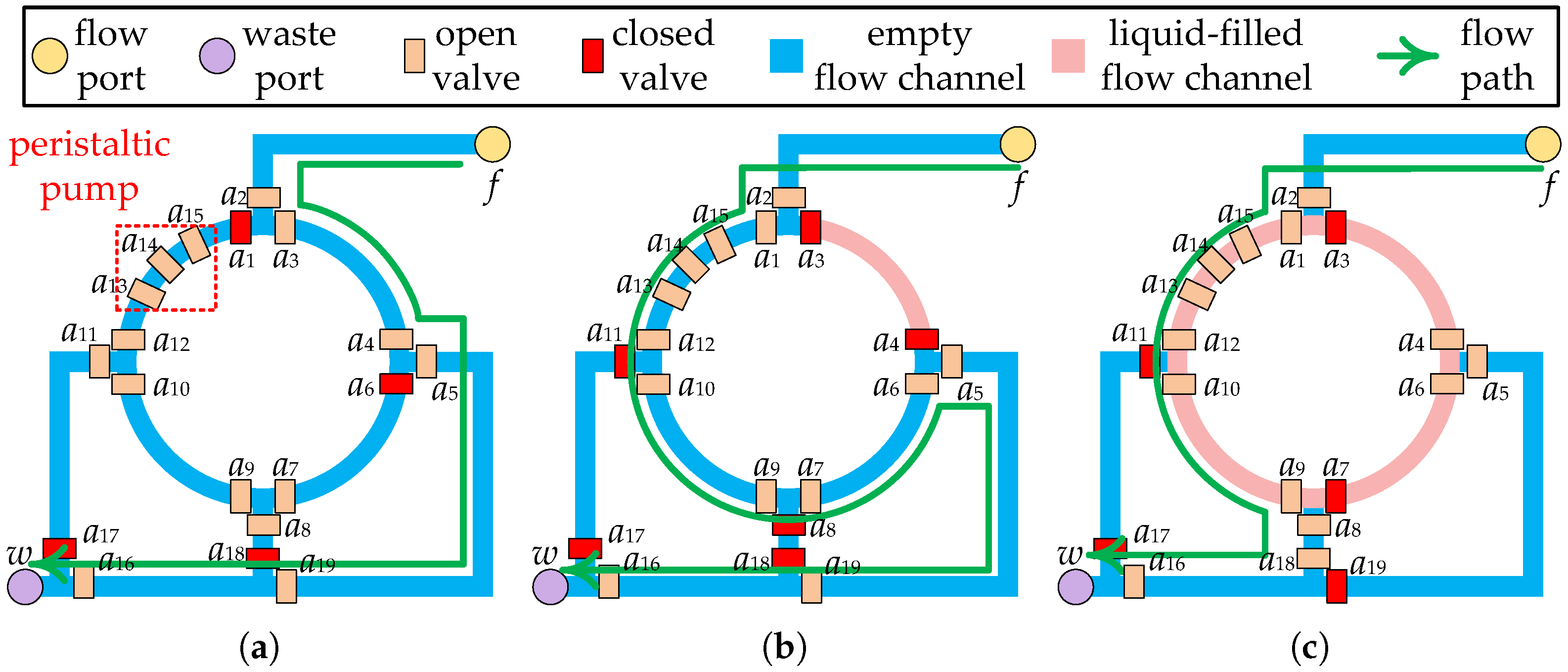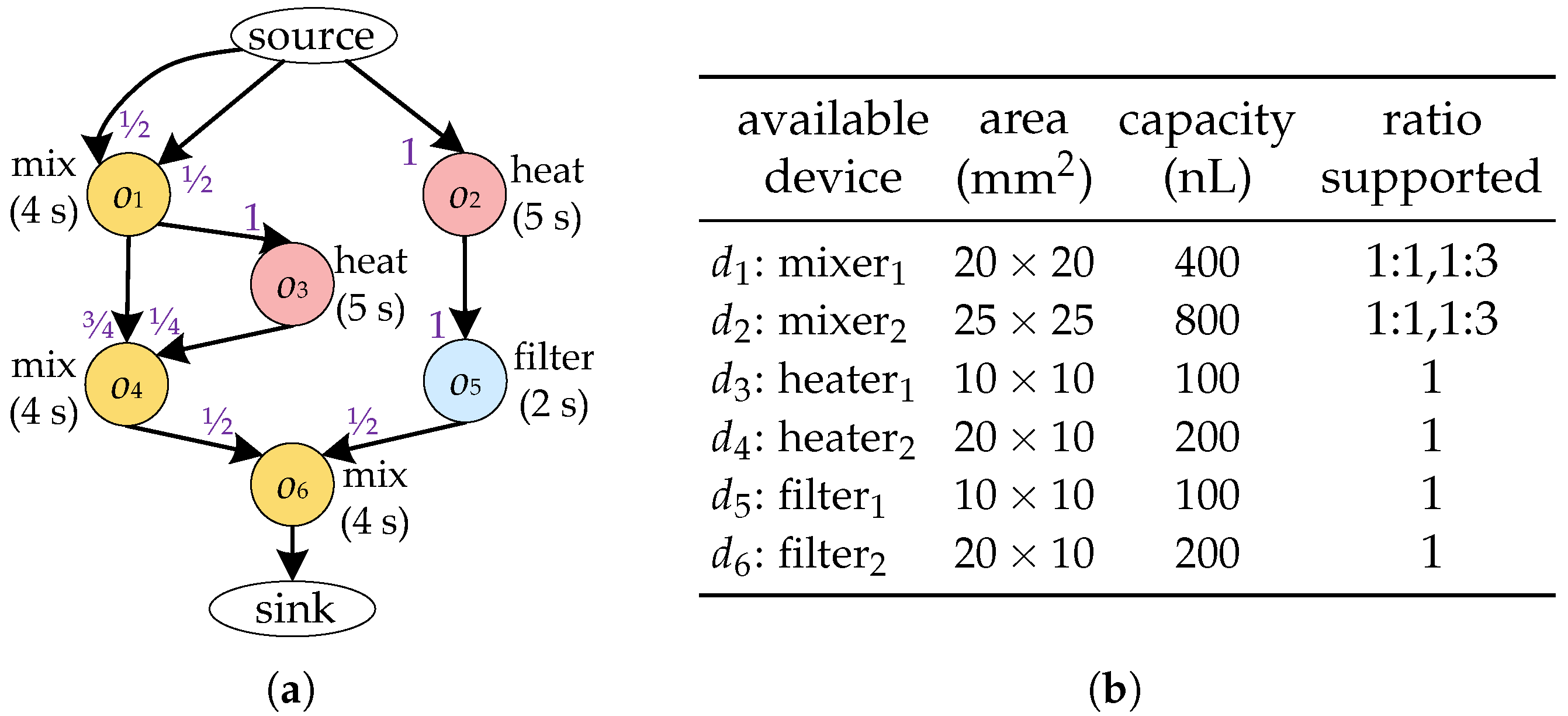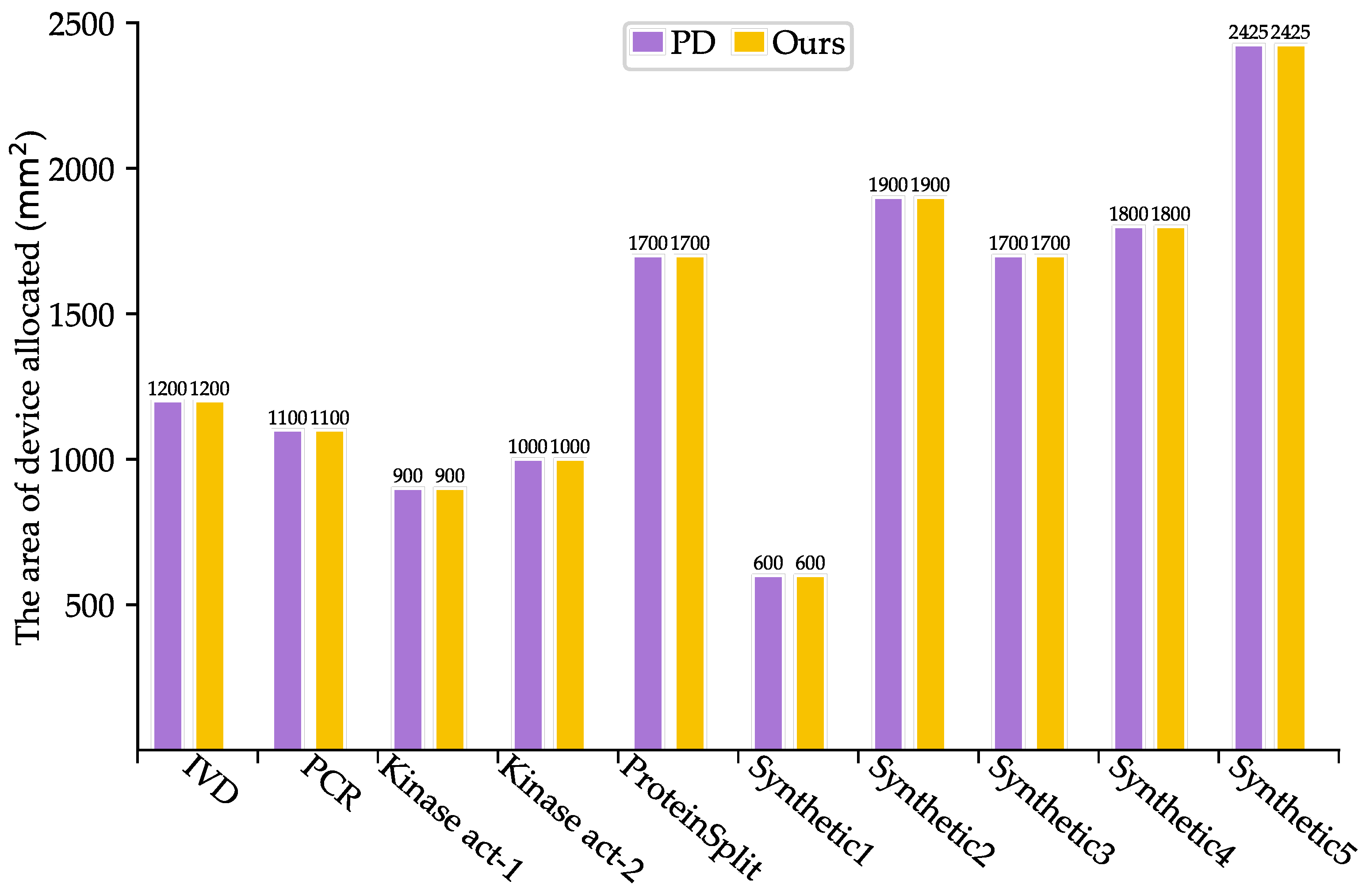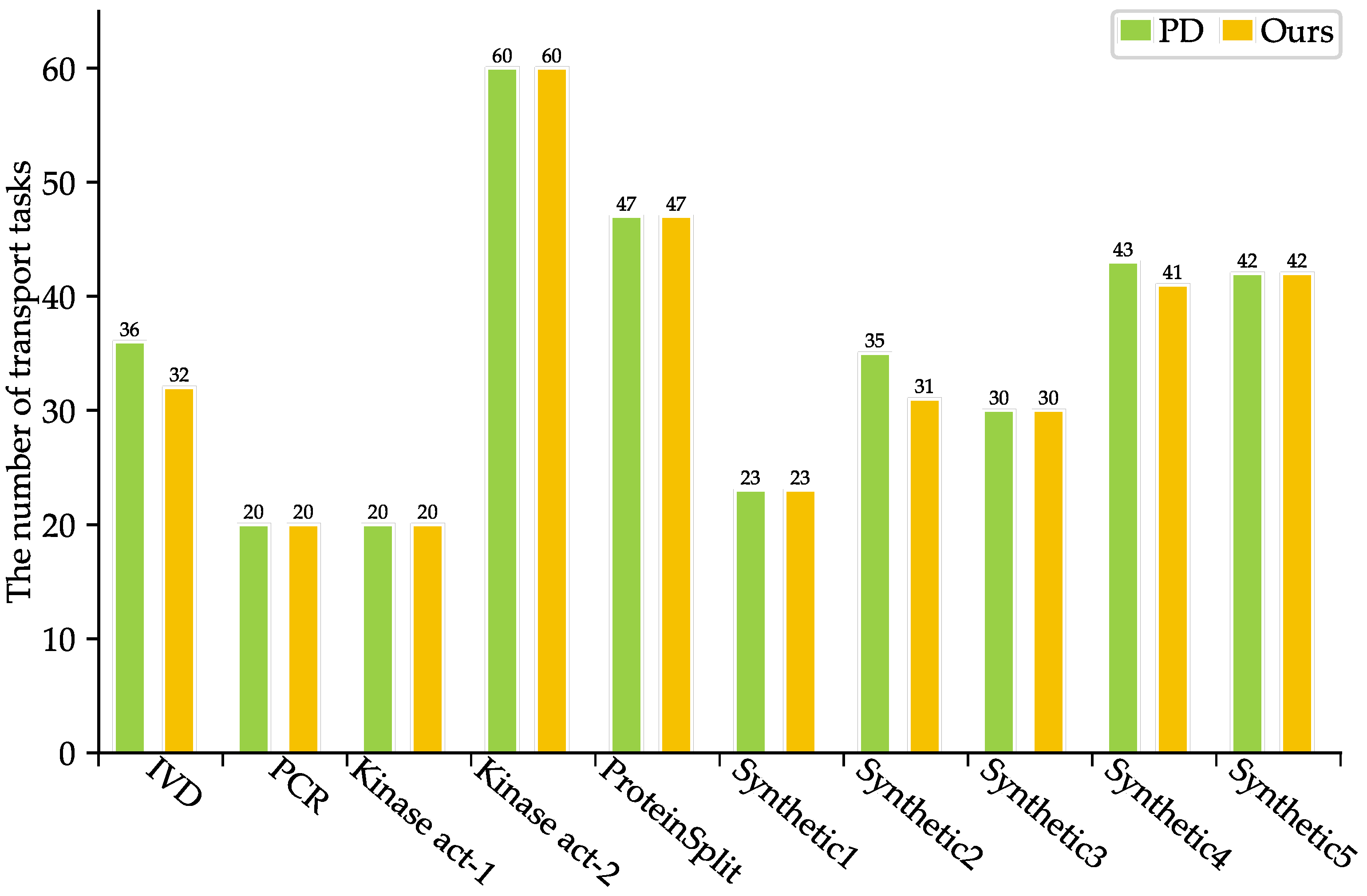SlimPort: Port-Driven High-Level Synthesis for Continuous-Flow Microfluidic Biochips
Abstract
1. Introduction
- A reduction in the fluidic port number is incorporated into high-level synthesis for the first time, thereby reducing the fabrication cost and improving the reliability of CFMBs.
- We propose extended volume management to achieve volume constraints for devices with a non-fixed input/output ratio, ensuring the correctness of bioassay outcomes.
- We propose two acceleration strategies for integer linear programming (ILP), scheduling constraint reduction and upper boundary estimation of the port number, to reduce the complexity of the ILP model and speed up the time required to solve it.
- The effectiveness of SlimPort is demonstrated by experimental results on five real-world bioassays and five synthetic benchmarks.
2. High-Level Synthesis, Motivation, and Problem Formulation
2.1. Volume Management Between Devices with Non-Fixed Input/Output Ratio and Binding
2.2. Optimization of Fluidic Port Number and Scheduling
2.3. Problem Formulation
- A bioassay modeled as a sequencing graph with the type and duration of each operation, as well as the volume ratio of each input.
- A device library D with the area and capacity of each device and the input/output ratios supported by each device.
- A binding scheme satisfying the volume constraints between devices.
- The volume of fluid output from each operations.
- A scheduling scheme indicating the start and end time for each operation and each transport task.
- The completion time of the bioassay.
- The number of fluidic ports required.
- The total area of devices employed.
- The volume of excess fluid and waste fluid.
3. Details of the Proposed Port-Driven High-Level Synthesis
3.1. ILP Model Constructed by SlimPort
3.1.1. Binding with Extended Volume Management
3.1.2. Scheduling with Optimization of Fluidic Ports
3.1.3. Optimization Objective
3.2. Acceleration Strategies
3.2.1. Scheduling Constraint Reduction
3.2.2. Upper Boundary Estimation of Fluidic Port Number
| Algorithm 1: Upper Boundary Estimation of Fluidic Port Number |
| Input: The sequencing graph and the device library D Output: The upper boundary of fluidic port number 1 for each do 2 ; 3 Add all into ; 4 Add all into ; 5 Initialize a stack and push all into ; 6 while do 7 ; 8 Push all into ; 9 Add all into ; 10 end while 11 end for 12 Construct an edge-compatible graph with each node representing any edge in E, and if , then connect the nodes corresponding to these and with a single edge; 13 Get all maximal cliques in the edge-compatible graph; 14 for each do 15 Get the parent operations corresponding to the edge nodes in and count the number of operations of each type, denoted as , where is the type number of all device in D; 16 Get the child operations corresponding to the edge nodes in and count the number of operations of each type, denoted as ; 17 , where is the number of devices with type i; 18 end for 19 |
4. Experimental Results
4.1. Validation of the Proposed SlimPort
4.2. Validation of the Acceleration Strategies
5. Conclusions
Author Contributions
Funding
Institutional Review Board Statement
Informed Consent Statement
Data Availability Statement
Conflicts of Interest
Abbreviations
| PDMS | Polydimethylsiloxane |
| CFMB | Continuous-flow microfluidic biochip |
| ILP | Integer linear programming |
References
- Huang, X.; Ho, T.Y.; Guo, W.; Li, B.; Chakrabarty, K.; Schlichtmann, U. Computer-Aided Design Techniques for Flow-Based Microfluidic Lab-on-a-Chip Systems. ACM Comput. Surv. 2021, 54, 97. [Google Scholar] [CrossRef]
- Liu, G.; Huang, H.; Chen, Z.; Lin, H.; Liu, H.; Huang, X.; Guo, W. Design Automation for Continuous-Flow Microfluidic Biochips: A Comprehensive Review. Integration 2022, 82, 48–66. [Google Scholar] [CrossRef]
- Chin, C.D.; Laksanasopin, T.; Cheung, Y.K.; Steinmiller, D.; Linder, V.; Parsa, H.; Wang, J.; Moore, H.; Rouse, R.; Umviligihozo, G.; et al. Microfluidics-Based Diagnostics of Infectious Diseases in the Developing World. Nat. Med. 2011, 17, 1015–1019. [Google Scholar] [CrossRef] [PubMed]
- Huang, S.P.; Chuang, Y.J.; Lee, W.B.; Tsai, Y.C.; Lin, C.N.; Hsu, K.F.; Lee, G.B. An Integrated Microfluidic System for Rapid, Automatic and High-Throughput Staining of Clinical Tissue Samples for Diagnosis of Ovarian Cancer. Lab Chip 2020, 20, 1103–1109. [Google Scholar] [CrossRef] [PubMed]
- Chu, Y.; Gao, Y.; Tang, W.; Qiang, L.; Han, Y.; Gao, J.; Zhang, Y.; Liu, H.; Han, L. Attomolar-Level Ultrasensitive and Multiplex microRNA Detection Enabled by a Nanomaterial Locally Assembled Microfluidic Biochip for Cancer Diagnosis. Anal. Chem. 2021, 93, 5129–5136. [Google Scholar] [CrossRef] [PubMed]
- Kartalov, E.P.; Zhong, J.F.; Scherer, A.; Quake, S.R.; Taylor, C.R.; Anderson, W.F. High-Throughput Multi-Antigen Microfluidic Fluorescence Immunoassays. BioTechniques 2006, 40, 85–90. [Google Scholar] [CrossRef] [PubMed]
- Zhao, M.; Li, X.; Zhang, Y.; Wang, Y.; Wang, B.; Zheng, L.; Zhang, D.; Zhuang, S. Rapid Quantitative Detection of Chloramphenicol in Milk by Microfluidic Immunoassay. Food Chem. 2021, 339, 127857. [Google Scholar] [CrossRef] [PubMed]
- Zheng, L.; Zhao, M.; Dai, B.; Xue, Z.; Kang, Y.; Liu, S.; Hou, L.; Zhuang, S.; Zhang, D. Integrated System for Rapid Enrichment and Detection of Airborne Polycyclic Aromatic Hydrocarbons. Sci. Total Environ. 2023, 864, 161057. [Google Scholar] [CrossRef] [PubMed]
- Unger, M.A.; Chou, H.P.; Thorsen, T.; Scherer, A.; Quake, S.R. Monolithic Microfabricated Valves and Pumps by Multilayer Soft Lithography. Science 2000, 288, 113–116. [Google Scholar] [CrossRef] [PubMed]
- Li, M.; Tseng, T.M.; Li, B.; Ho, T.Y.; Schlichtmann, U. Component-Oriented High-Level Synthesis for Continuous-Flow Microfluidics Considering Hybrid-Scheduling. In Proceedings of the 2017 54th ACM/EDAC/IEEE Design Automation Conference (DAC), Austin, TX, USA, 18–22 June 2017; pp. 1–6. [Google Scholar] [CrossRef]
- Huang, C.M.; Liu, C.H.; Huang, J.D. Volume-Oriented Sample Preparation for Reactant Minimization on Flow-Based Microfluidic Biochips with Multi-Segment Mixers. In Proceedings of the 2015 Design, Automation & Test in Europe Conference & Exhibition (DATE), EDA Consortium, Grenoble, France, 9–13 March 2015; pp. 1114–1119. [Google Scholar]
- Thorsen, T.; Maerkl, S.J.; Quake, S.R. Microfluidic Large-Scale Integration. Science 2002, 298, 580–584. [Google Scholar] [CrossRef] [PubMed]
- Melin, J.; Quake, S.R. Microfluidic Large-Scale Integration: The Evolution of Design Rules for Biological Automation. Annu. Rev. Biophys. 2007, 36, 213–231. [Google Scholar] [CrossRef] [PubMed]
- Hu, K.; Chakrabarty, K.; Ho, T.Y. Computer-Aided Design of Microfluidic Very Large Scale Integration (mVLSI) Biochips; Springer: Cham, Switzerland, 2017; pp. 26–27. [Google Scholar] [CrossRef]
- Perkel, J.M. Life Science Technologies: Microfluidics—Bringing New Things to Life Science. Science 2008, 322, 975–977. [Google Scholar] [CrossRef]
- Huang, X.; Ho, T.Y.; Li, Z.; Liu, G.; Wang, L.; Li, Q.; Guo, W.; Li, B.; Schlichtmann, U. MiniControl 2.0: Co-Synthesis of Flow and Control Layers for Microfluidic Biochips with Strictly Constrained Control Ports. IEEE Trans. Comput.-Aided Des. Integr. Circuits Syst. 2022, 41, 5449–5463. [Google Scholar] [CrossRef]
- Stanford Microfluidics Foundry Basic Design Tips. Available online: https://www.stanfordmicrofluidics.com/design-basics (accessed on 2 April 2025).
- Tseng, T.M.; Li, M.; Freitas, D.N.; McAuley, T.; Li, B.; Ho, T.Y.; Araci, I.E.; Schlichtmann, U. Columba 2.0: A Co-Layout Synthesis Tool for Continuous-Flow Microfluidic Biochips. IEEE Trans. Comput.-Aided Des. Integr. Circuits Syst. 2018, 37, 1588–1601. [Google Scholar] [CrossRef]
- Liu, C.; Huang, X.; Li, B.; Yao, H.; Pop, P.; Ho, T.Y.; Schlichtmann, U. DCSA: Distributed Channel-Storage Architecture for Flow-Based Microfluidic Biochips. IEEE Trans. Comput.-Aided Des. Integr. Circuits Syst. 2021, 40, 115–128. [Google Scholar] [CrossRef]
- Huang, X.; Pan, Y.; Chen, Z.; Guo, W.; Wang, L.; Li, Q.; Wille, R.; Ho, T.Y.; Schlichtmann, U. Design Automation for Continuous-Flow Lab-on-a-Chip Systems: A One-Pass Paradigm. IEEE Trans. Comput.-Aided Des. Integr. Circuits Syst. 2023, 42, 327–331. [Google Scholar] [CrossRef]
- Zhu, Y.; Liu, G.; Guo, W.; Huang, X. FTCD: Fault-Tolerant Co-Design of Flow and Control Layers for Fully Programmable Valve Array Biochips. IEEE Trans. Comput.-Aided Des. Integr. Circuits Syst. 2025, 1–14. [Google Scholar] [CrossRef]
- Huang, X.; Cai, H.; Guo, W.; Liu, G.; Ho, T.Y.; Chakrabarty, K.; Schlichtmann, U. Control-Logic Synthesis of Fully Programmable Valve Array Using Reinforcement Learning. IEEE Trans. Comput.-Aided Des. Integr. Circuits Syst. 2024, 43, 277–290. [Google Scholar] [CrossRef]
- Liu, G.; Zeng, Y.; Zhu, Y.; Cai, H.; Guo, W.; Li, Z.; Ho, T.Y.; Huang, X. Towards Automated Testing of Multiplexers in Fully Programmable Valve Array Biochips. In Proceedings of the 2024 29th Asia and South Pacific Design Automation Conference (ASP-DAC), Incheon, Republic of Korea, 22–25 January 2024; pp. 570–575. [Google Scholar] [CrossRef]
- Minhass, W.H.; Pop, P.; Madsen, J. System-Level Modeling and Synthesis of Flow-Based Microfluidic Biochips. In Proceedings of the 2011 14th International Conference on Compilers, Architectures and Synthesis for Embedded Systems (CASES), Taipei, Taiwan, 9–14 October 2011; pp. 225–233. [Google Scholar] [CrossRef]
- Dinh, T.A.; Yamashita, S.; Ho, T.Y.; Hara-Azumi, Y. A Clique-Based Approach to Find Binding and Scheduling Result in Flow-Based Microfluidic Biochips. In Proceedings of the 2013 18th Asia and South Pacific Design Automation Conference (ASP-DAC), Yokohama, Japan, 22–25 January 2013; pp. 199–204. [Google Scholar] [CrossRef]
- Huang, X.; Pan, Y.; Zhang, G.L.; Li, B.; Guo, W.; Ho, T.Y.; Schlichtmann, U. PathDriver+: Enhanced Path-Driven Architecture Design for Flow-Based Microfluidic Biochips. IEEE Trans. Comput.-Aided Des. Integr. Circuits Syst. 2022, 41, 2185–2198. [Google Scholar] [CrossRef]
- Chen, Z.; Zhu, Y.; Chen, Z.; Chen, Z.; Liu, G. High-Level Synthesis for Microfluidic Biochips Considering Actual Volume Management and Channel Storage. In Proceedings of the 2024 25th International Symposium on Quality Electronic Design (ISQED), San Francisco, CA, USA, 3–5 April 2024; pp. 1–8. [Google Scholar] [CrossRef]
- Ye, Z.; Chen, Z.; Pan, Y.; Liu, G.; Guo, W.; Ho, T.Y.; Huang, X. Timing-Driven High-Level Synthesis for Continuous-Flow Microfluidic Biochips. In Proceedings of the 2024 25th International Symposium on Quality Electronic Design (ISQED), San Francisco, CA, USA, 3–5 April 2024; pp. 1–6. [Google Scholar] [CrossRef]
- Bron, C.; Kerbosch, J. Algorithm 457: Finding All Cliques of an Undirected Graph. Commun. ACM 1973, 16, 575–577. [Google Scholar] [CrossRef]







|
| Benchmarks | ||||
|---|---|---|---|---|
| /(|mixer|, |heater|, |filter|, |separator|, |detector|, |storage|)/ | ||||
| PCR | IVD | ProteinSplit | Kinase act-1 | Kinase act-2 |
| 7/(4, 0, 0, 0, 0, 1)/15 | 12/(4, 0, 0, 0, 4, 1)/24 | 14/(4, 0, 0, 3, 3, 1)/27 | 4/(4, 0, 0, 4, 0, 1)/16 | 12/(4, 0, 0, 4, 0, 1)/48 |
| Synthetic1 | Synthetic2 | Synthetic3 | Synthetic4 | Synthetic5 |
| 10/(4, 2, 3, 0, 2, 1)/15 | 15/(4, 3, 2, 0, 3, 1)/21 | 20/(4, 4, 3, 4, 2, 1)/28 | 25/(4, 4, 3, 0, 2, 1)/33 | 30/(4, 3, 3, 2, 4, 1)/42 |
| Benchmarks | (s) | (nL) | |||||||
|---|---|---|---|---|---|---|---|---|---|
| PD | Ours | Imp (%) | PD | Ours | Imp (%) | PD | Ours | Imp (%) | |
| IVD | 29 | 29 | 0.00 | 1200 | 1000 | 16.67 | 12 | 4 | 66.67 |
| PCR | 24 | 24 | 0.00 | 1000 | 800 | 20.00 | 6 | 2 | 66.67 |
| Kinase act-1 | 35 | 35 | 0.00 | 600 | 600 | 0.00 | 4 | 2 | 50.00 |
| Kinase act-2 | 52 | 52 | 0.00 | 1300 | 900 | 30.77 | 12 | 4 | 66.67 |
| ProteinSplit | 88 | 88 | 0.00 | 2300 | 2300 | 0.00 | 8 | 4 | 50.00 |
| Synthetic1 | 33 | 33 | 0.00 | 1200 | 1200 | 0.00 | 6 | 4 | 33.33 |
| Synthetic2 | 39 | 39 | 0.00 | 1600 | 1100 | 31.25 | 6 | 4 | 33.33 |
| Synthetic3 | 53 | 53 | 0.00 | 200 | 200 | 0.00 | 4 | 2 | 50.00 |
| Synthetic4 | 54 | 54 | 0.00 | 1500 | 1100 | 26.67 | 12 | 4 | 66.67 |
| Synthetic5 | 67 | 67 | 0.00 | 400 | 400 | 0.00 | 6 | 4 | 33.33 |
| Average | - | 0.00 | - | 12.54 | - | 51.67 | |||
Disclaimer/Publisher’s Note: The statements, opinions and data contained in all publications are solely those of the individual author(s) and contributor(s) and not of MDPI and/or the editor(s). MDPI and/or the editor(s) disclaim responsibility for any injury to people or property resulting from any ideas, methods, instructions or products referred to in the content. |
© 2025 by the authors. Licensee MDPI, Basel, Switzerland. This article is an open access article distributed under the terms and conditions of the Creative Commons Attribution (CC BY) license (https://creativecommons.org/licenses/by/4.0/).
Share and Cite
Pan, Y.; Xu, Y.; Chen, Z.; Huang, X.; Liu, G. SlimPort: Port-Driven High-Level Synthesis for Continuous-Flow Microfluidic Biochips. Micromachines 2025, 16, 577. https://doi.org/10.3390/mi16050577
Pan Y, Xu Y, Chen Z, Huang X, Liu G. SlimPort: Port-Driven High-Level Synthesis for Continuous-Flow Microfluidic Biochips. Micromachines. 2025; 16(5):577. https://doi.org/10.3390/mi16050577
Chicago/Turabian StylePan, Youlin, Yanbo Xu, Ziyang Chen, Xing Huang, and Genggeng Liu. 2025. "SlimPort: Port-Driven High-Level Synthesis for Continuous-Flow Microfluidic Biochips" Micromachines 16, no. 5: 577. https://doi.org/10.3390/mi16050577
APA StylePan, Y., Xu, Y., Chen, Z., Huang, X., & Liu, G. (2025). SlimPort: Port-Driven High-Level Synthesis for Continuous-Flow Microfluidic Biochips. Micromachines, 16(5), 577. https://doi.org/10.3390/mi16050577







